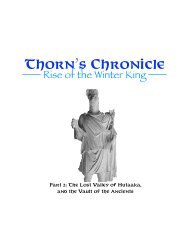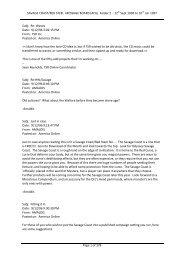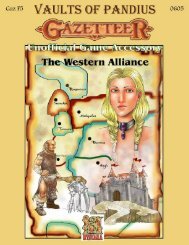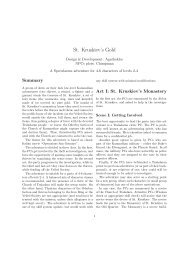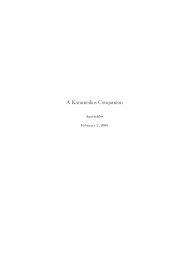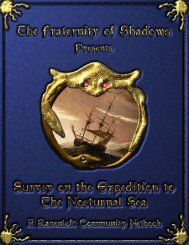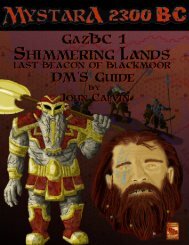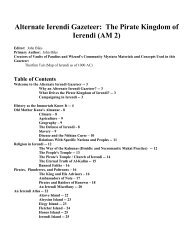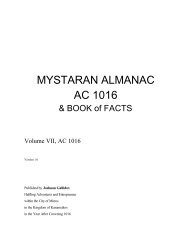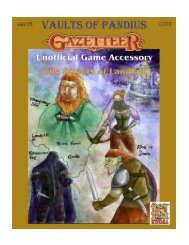Karameikos - Vaults of Pandius
Karameikos - Vaults of Pandius
Karameikos - Vaults of Pandius
Create successful ePaper yourself
Turn your PDF publications into a flip-book with our unique Google optimized e-Paper software.
The Demography <strong>of</strong> <strong>Karameikos</strong>with real-world Middle Age knownpopulation densities.Normally, tracing a comparison betweenhigh-fantasy, high-magic settings and the realworld would be tricky, because things likeclerical magic (with create food and waterspells and the like) and other supernaturalways to feed a large number <strong>of</strong> people couldalter the population figures and the urbanruralpopulation ratio quite a lot. However,<strong>Karameikos</strong> is quite a low-magic setting - aMedieval-style feudal country where magicdoes not seem to be a feature <strong>of</strong> everyday life;thus, real-world demography can indeed beused as inspiration and reference to solvesome <strong>of</strong> the issues to which Karameikanpopulation figures shown in <strong>of</strong>ficialsupplements give birth.average density <strong>of</strong> about 100, whileFlorence’s countryside even reached 240inhabitants per square mile (withoutcounting cities). The eastern and northernregions <strong>of</strong> Europe were much less populous:the Balkans had about 23 inhabitants persquare mile, while Scandinavia had 5.5 andRussia 7.3. Urbanization (cities with 10,000people or more) was very low: it went from18% in Italy and the Low Countries, to 12%<strong>of</strong> Spain, to 5% <strong>of</strong> France and the Balkans to0% <strong>of</strong> places like Scandinavia and Scotland.The urban-rural population ratio <strong>of</strong> 1:20 wasthus exceeded only in very rare cases andeven then only in countries (like the Italianpeninsula) with a stable and old urbantradition, and/or where cities had becomecenters <strong>of</strong> trade and politics.A LOOK AT MEDIEVALDEMOGRAPHYWhile not an exact science, real-worldMedieval demography has brought to lightsome estimates which help us understand thepopulation levels <strong>of</strong> Europe during theMiddle Ages. Without going into too muchdetail, and just for the sake <strong>of</strong> somecomparisons, let us consider some data. Inthe 15 th century, France, a country for whichmany historical sources are available, had anoverall density <strong>of</strong> 80 people per square mile,ranging from 150 in the area surroundingParis, to 100 in the most settled areas(Normandy, Picardy, Savoy, and Burgundy),to 60 in most <strong>of</strong> the average-populatedcountry (central France, Provence,Champagne), to less than 40 in scarcelypopulated areas (like the Pyrenees andGascony). Tuscany, in the same years, had anPOSSIBLE TAKES ONKARAMEIKANDEMOGRAPHYBack to our Grand Duchy; a frontier landlike <strong>Karameikos</strong>, with 300,000 people andan overall density <strong>of</strong> 7.6 inhabitants persquare mile, can hardly justify an urbanpopulation <strong>of</strong> 30% in a Medieval-stylesetting. This holds true even if the impact <strong>of</strong>magic in your campaign is considered; toactually justify the above number, the magictheme needs to be pushed well over thelimits <strong>of</strong> the low-magic description <strong>of</strong><strong>Karameikos</strong> given in GAZ1 – incurring therisk <strong>of</strong> altering too greatly the classic manner<strong>of</strong> depicting the Grand Duchy. Of course, ahigh magic variant is possible, but the goal<strong>of</strong> this article is to provide two additional,different paths to solve these supposedinconsistencies.7THRESHOLD: The Mystara Magazine Issue #1



